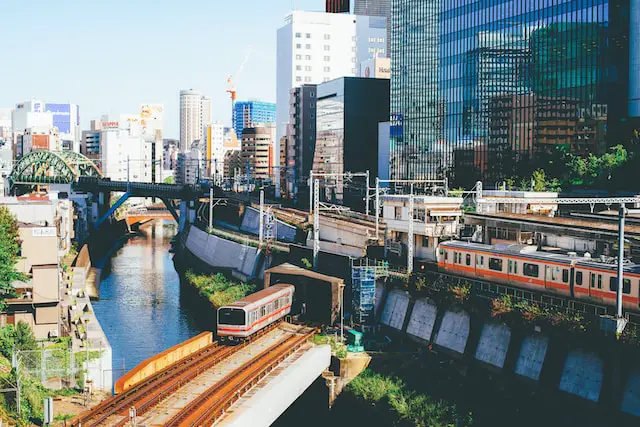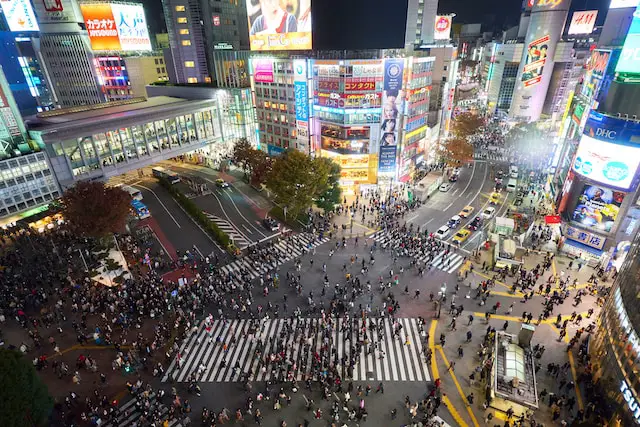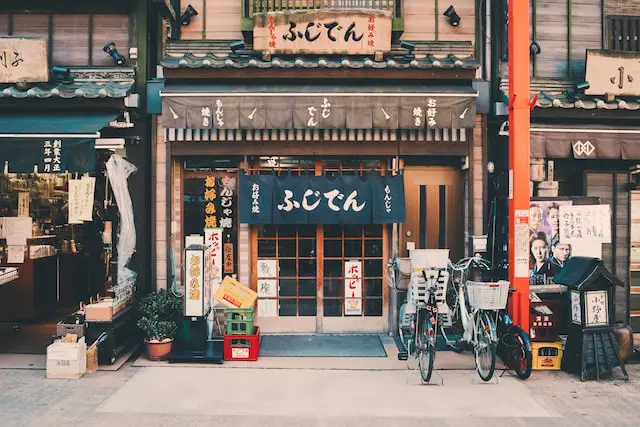If there’s one thing Japan is famed for, it’s efficiency, and this trait shines in their much-acclaimed train system. The Japanese train system is a precision marvel, operating like clockwork, ensuring punctuality and reliability. This is not just limited to the local commuter lines; even the Shinkansen – Japan’s world-renowned Bullet Train, epitomizes the same values.
Mastering train travel in Japan, especially the Shinkansen, can significantly transform your journey, offering a faster, smoother, and more enriching experience. Our guide aims to explore the nuances of the Japanese train system, offering insights that aren’t just about reaching your destination effectively but also about enjoying the journey amidst Japan’s unique train culture.
Japanese Train Travel Basics
If you’re planning to navigate through Japan, understanding the different types of services and lines, such as the JR (Japan Railways Group) lines, private railways, and subway lines, can be beneficial. These operate efficiently across the country, each serving a distinct purpose. The JR lines are the primary train networks covering longer distances, including nationwide shinkansen (bullet train) services. Private railways offer valuable connections in metropolitan areas, while subway lines are ideal for quick city transits.
Learning how to read the station signs and route maps is critical when boarding these services. They are usually written in both Japanese Kanji and English. Note that characters may sometimes use Romaji (Japanese words spelled with the Roman alphabet) alongside original Kanji and English, making it easier for non-Japanese speakers. Station names, departure times, and platform numbers are clearly stated.
Each station showcases detailed route maps, designating the journey direction and interchange stations, helping you make seamless transfers. These maps use Color coding daily, helping you quickly identify the desired train service and advice. Look for English translations below or next to the Japanese characters. Some prominent city stations offer multilingual guidance systems, making finding your way even more straightforward.
In essence, train travel in Japan is engineered to be an efficient and pleasant experience, encouraging you to explore the land of the rising sun seamlessly.
Shinkansen: The Bullet Train Experience
If you’re searching for the epitome of speed and convenience in train travel in Japan, look no further than the Shinkansen, the Japanese bullet train. With its iconic streamlined trains, this spectacular train system boasts remarkable speed and coverage across major cities in Japan.
Shinkansen trains are divided into several types based on speed and the number of stops they make. The Nozomi, for example, is the fastest among them. They can reach speeds up to 300 km/h and swiftly cover the distance between Tokyo and Osaka in around 2 hours and 30 minutes. On the other end, you have the Kodama, which stops at every station and is therefore slower but offers a more leisurely view of Japan’s countryside.
Another popular type of Shinkansen is the Hikari, which is slightly slower than the Nozomi but stops at more stations along the way. Other types include the Sakura (primarily serving the Kyushu region), the Hayabusa (connecting Tokyo to the northern tip of Honshu), and the Tsubasa (mainly serving the Yamagata region).
But the Shinkansen experience is not limited to its incredible speed or reach. The punctuality of these services is nothing short of legendary. These trains are so punctual that any departure delayed by more than one minute is considered later!
To experience the true spirit of train travel in Japan, you must unquestionably onboard the Shinkansen. After all, the thrill of traveling at a bullet’s speed, comfortably seated, and appreciating the rapidly shifting panorama of Japanese landscapes fundamentally transforms your journey into a remarkable memory.
Ticketing System and Rail Passes
If you plan to travel extensively throughout Japan, understanding the country’s ticketing system and the strategic use of rail passes can significantly impact your journey. Japanese train tickets can be purchased at convenient ticket machines found at every station. These machines offer English guidance, allowing efficient purchase transactions. One can buy tickets for immediate use or reserve them for future travel dates.
Beyond individual tickets, Japan offers various rail passes, like the acclaimed Japan Rail Pass, which is exclusively for non-Japanese tourists. This pass provides unlimited travel on all Japan Railways (JR) lines and most Shinkansen trains, from a week to a few months. While it comes with the perk of unlimited rides, it may not always offer the best value if your itinerary doesn’t include lots of long-distance travel. Therefore, weighing your options beforehand is crucial.
Also, regional passes like the JR East Pass, JR Hokkaido Pass, or Kansai Thru Pass might offer a better economy for travel within specific regions. Usually available for residents and tourists, these passes can be more cost-effective if your trip is limited to a particular area.
Remember, reservations are highly recommended for Shinkansen trains, especially during peak travel. While unreserved cars are available, securing a seat will ensure a more comfortable journey.
Understanding the Japanese train ticketing system can initially seem intimidating, but rest assured, it soon becomes second nature with a bit of patience and practice. It’s all part of the remarkable experience of train travel in Japan.
Etiquette and Culture Embedded in Train Travel
The Japanese train system is not just a symbol of the country’s technological advancements; it also reflects the finesse and respectfulness intrinsic to Japanese society. Whether you are a local or a tourist, following the Japanese train etiquette is a demonstrated sign of respect for the culture and locals.
One of the most distinguishable aspects is the atmosphere of quietness that envelops each carriage. Conversations are usually hushed, and phone usage is kept to a bare minimum – even the ringtones are expected to be off. This goes a long way in contributing to a comfortable and serene travel environment for everyone.
Cleanliness and hygiene are also heavily emphasized, with trash cans provided at every station for litter disposal. Eating on local trains is considered impolite while consuming food on Shinkansen and long-distance trains is acceptable, given the seats are cleaned up afterward.
For commuting, seats are typically filled from the window side and outwards, and the utmost courtesy is observed when seating or standing near the priority seats reserved for older people and those in need. Queuing in ordered lines is also customary, following the marked lanes at station platforms. No rushing or cutting in line is practiced, even during peak hours.
The cultural norms in Japan concerning public transport are deeply rooted, and adhering to them does not just significantly enhance your travel experience, it also elicits a sense of respectful camaraderie among the passengers, making every journey on the efficient Japanese trains one to remember. When understood and embraced, these norms provide valuable insight into a society where respect and harmony preside.
Enjoying Scenic Views and Ekiben: Elevating the Japanese Train Experience
When thinking of train travel in Japan, one often envisions the speed and efficiency of the Shinkansen. However, the experience extends far beyond that. Japan’s rail network is a gateway to the country’s scenic beauty, providing front-row seats to stunning landscapes every season.
In winter, journey through the snowy terrains of Hokkaido, while in spring, the Kansai route bursts into a pink bloom with cherry blossoms. Choose your travel route wisely to witness this captivating transformation of landscapes via the comfort of your train seat.
On the other hand, a train journey in Japan wouldn’t be complete without exploring Ekiben, the regional bentos sold at Japanese train stations. Immerse in this brought-to-life Bento-box culture as each region flaunts its local produce and culinary tradition through these meal boxes.
Whether it’s the beautifully arranged seafood Ekiben of Hokkaido or Nagano’s soba-themed bentos, dive into Japan’s gastronomic journey while watching the scenery blur past. The #Ekiben has become part of Japan’s train travel culture, seeping into local tourism, shopping, and dining joys.
The marriage of scenic vistas and the unmissable Ekiben gives a fittingly extraordinary dimension to the Japanese train experience. When you board a train in Japan, buckle up for an adventure that thrills in every bite and every sight.
Dealing with Complexities: Delays, Crowds, and Lost Items
While train travel in Japan is known for its unwavering punctuality, there might still be occasional and unforeseen delays. If you happen to experience any, stay calm and wait for announcements. Most train companies, whether for the Shinkansen or the regular Japanese train lines, go above and beyond to rectify delays swiftly and efficiently.
Another challenge for those unfamiliar with the system might be the peak hours in Japan. During rush hour, trains become packed with commuters. Subsequently, consider traveling outside peak times, typically outside 7:30-9:00 in the morning and 5:00-8:00 in the evening. Trains are generally more crowded during travel seasons such as Golden Week and the New Year holiday, so advance tickets are recommended.
If you unfortunately lose any of your belongings, there is a good chance that they will be returned. Lost items are routinely collected and put in the lost and found at the stationmaster’s office. You’ll need to provide a detailed description of your lost items on Japanese trains, so having a picture would be handy.
Despite minor complexities, maneuvering the Japanese train system is an orderly and straightforward experience, even in its rarer chaotic moments. Remember, the key to a smooth and enjoyable journey lies in understanding and adapting to the rhythm of the Japanese train travel culture.
Conclusion
Understanding the richness and efficiency of the Japanese train system cannot be overstated. It truly expands and amplifies your travel experience by leaps and bounds. As you have seen from this comprehensive guide, navigating the expansive web of Japanese railways highly rewards those who dare to venture. Traveling across Japan becomes more than a journey; it’s a cultural experience that leaves you with lasting memories.
From the high-speed Shinkansen that links major cities, offering unprecedented efficiency, to the scenic train routes that give you a glimpse of Japan’s stunning landscapes, one cannot overlook the charm and practicality of train travel in Japan. The unique culture and etiquette accompanying train travel reflect Japan’s respect for community spaces and provide a fascinating insight into local sensibilities. Be it the silence that serenely encapsulates the train carriages or the palate-awakening Ekiben at the station bento stands, there is much to be cherished.
Despite its complexities – such as coping with train delays, finding your way around crowded stations during peak hours, and recovering lost items – the system is designed with a sense of order and respect, making these processes relatively straightforward. Should you invest the time to master these aspects, you will find train travel in Japan a breeze.
In your hands lies the key to unlocking an authentic, hassle-free, and enriching travel experience through the soul of Japan – its pitch-perfect train system. We encourage you to engage with this quintessential part of Japanese life, stepping aboard and embarking on an unforgettable journey!
As your guides in this wondrous land, we hope this Japanese train travel guide has inspired you to explore Japan like never before. Bon Voyage!




